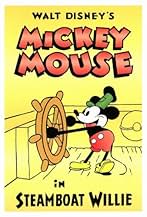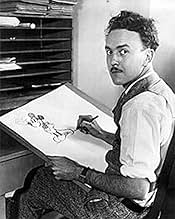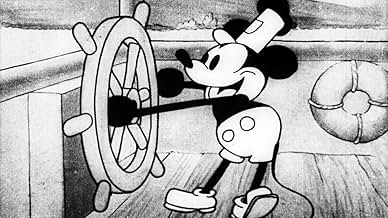CALIFICACIÓN DE IMDb
7.4/10
12 k
TU CALIFICACIÓN
Mickey Mouse es un travieso marinero en un barco fluvial que está bajo el mando del tiránico capitán Pedro.Mickey Mouse es un travieso marinero en un barco fluvial que está bajo el mando del tiránico capitán Pedro.Mickey Mouse es un travieso marinero en un barco fluvial que está bajo el mando del tiránico capitán Pedro.
- Dirección
- Guionistas
- Elenco
- Premios
- 1 premio ganado en total
Walt Disney
- Mickey Mouse
- (voz)
- (sin créditos)
- …
- Dirección
- Guionistas
- Todo el elenco y el equipo
- Producción, taquilla y más en IMDbPro
Opiniones destacadas
While in France as Germaine Dulac created a benchmark of short-subject, cinematic surrealism with The Seashell and the Clergyman, Walt Disney and his collaborator Ub Iwerks in America worked on Steamboat Willie, the most prominent of the early synchronized sound cartoons (it was revealed that this was not the first, contrary to other reports). It's also one of the more successfully simplistic and funny of the Mickey Mouse shorts (still in a silent-film way- the only sounds are little irks and bleeps from the Mickey and the animals). It also goes by fairly quickly for its less-than-ten minute run, if only by how quick and dopey the gags are.
But in these minutes one gets the immediate sense of how much fun Disney has with his characters, and how the newfound use of sound changes how his creation uses the animals as musical tools. There's no story to speak of, just random things that happens and occurs because of Mickey (err, Steamboat Willie) on this boat on a river. And like the better Mickey Mouse shorts, his lack of speaking acts as an advantage. It's a must-see if you haven't seen it as a kid, but if you have it might still be worth another look.
But in these minutes one gets the immediate sense of how much fun Disney has with his characters, and how the newfound use of sound changes how his creation uses the animals as musical tools. There's no story to speak of, just random things that happens and occurs because of Mickey (err, Steamboat Willie) on this boat on a river. And like the better Mickey Mouse shorts, his lack of speaking acts as an advantage. It's a must-see if you haven't seen it as a kid, but if you have it might still be worth another look.
"Steamboat Willie" is Mickey`s first movie, and was released way back in 1928. It is an atmospheric piece of movie history, and is a must see for every Disney-fan out there. If you don`t like Disney, you probably won`t like this movie.
A great debut for Mickey Mouse and it`s the first cartoon. As an old Disney-fan, I think that this is a brilliant movie. 10/10
A great debut for Mickey Mouse and it`s the first cartoon. As an old Disney-fan, I think that this is a brilliant movie. 10/10
10JV-6
Steamboat Willy was not the first cartoon to feature Mickey Mouse. The first film to star America's friend was "Plane Crazy". "Plane Crazy" was released May 15th 1928 in Hollywood California,in the silent movie format. "Steamboat Willy" was released November 18th 1928 as a SOUND movie (it was also released July 29th 1928 as a silent film). Thus making "Steamboat.."the first SOUND film of Mickey but NOT the first film for the little American Mouse. While many game shows have used the question: "What was the first appearance of Mickey Mouse?" The true answer is "Plane Crazy" not "Steamboat Willy". These dates can be checkout on IMDb under "release dates".
'Steamboat Willie (1928)' is often erroneously touted as the first Mickey Mouse film, though that title actually goes to 'Plane Crazy (1928).' The source fuelling this common misconception is probably an episode of "The Simpsons," which places the origin of Itchy the Mouse in a 1928 short called 'Steamboat Itchy,' obviously a parody of this cartoon. Interestingly, 'Steamboat Willie' was itself a parody, spoofing the latest Buster Keaton release, 'Steamboat Bill, Jr. (1928),' though the connection stretches little beyond the title and the general story setting. In this Walt Disney short, Mickey Mouse takes charge of a river steamboat, much to the annoyance of Captain Pete the cat, who spitefully casts him aside. But Mickey is not to be outdone in nastiness. Far removed from the pleasant, wholesome Mickey that more recent generations enjoyed, this little mouse cares only for numero uno, inflicting pain and displeasure on a series of farm animals in order to provide music for his own amusement.
First there's the laughing parrot, which cops a bucket and a large potato to the head. Then a goat is cranked by the tail to provide music ("Turkey in the Straw") from a guitar it has swallowed. A cat is swung around by its tail, a goose throttled about the throat, and a piglet viciously booted. For a children's cartoon, 'Steamboat Willie,' directed by Walt Disney and Ub Iwerks, certainly has some mean-spirited humour, though I also noticed similar elements (though not quite to this extent) in some later Disney shorts, like 'Gulliver Mickey (1934).' Let's not forget Minnie Mouse, of course, who suffers treatment for which she could today sue for sexual harassment! The jokes may be crude, and the animation perhaps even more so, but this cartoon delivers a bucket-full of laughs, and it's easy to see why this little rodent became one of the most beloved characters in cinema history. If you're a fan of Mickey Mouse, or Disney in general, this is one steamboat you can't afford to miss.
First there's the laughing parrot, which cops a bucket and a large potato to the head. Then a goat is cranked by the tail to provide music ("Turkey in the Straw") from a guitar it has swallowed. A cat is swung around by its tail, a goose throttled about the throat, and a piglet viciously booted. For a children's cartoon, 'Steamboat Willie,' directed by Walt Disney and Ub Iwerks, certainly has some mean-spirited humour, though I also noticed similar elements (though not quite to this extent) in some later Disney shorts, like 'Gulliver Mickey (1934).' Let's not forget Minnie Mouse, of course, who suffers treatment for which she could today sue for sexual harassment! The jokes may be crude, and the animation perhaps even more so, but this cartoon delivers a bucket-full of laughs, and it's easy to see why this little rodent became one of the most beloved characters in cinema history. If you're a fan of Mickey Mouse, or Disney in general, this is one steamboat you can't afford to miss.
A Walt Disney MICKEY MOUSE Cartoon.
STEAMBOAT WILLIE, a mischievous little rodent, neglects his pilothouse and frolics his way into cinematic history.
On 18 November 1928, a struggling young genius debuted the world's first successful cartoon with synchronous sound. There would be no looking back for either Walt Disney or his alter ego Mickey Mouse. Financial struggles would remain, but essentially the world was their oyster bed and Mickey would eventually rival Chaplin as the most recognizable cultural icon of the century.
As entertainment, STEAMBOAT WILLIE is still fun to watch, featuring fine work by animator Ub Iwerks and showing a Mickey with all the passions & indifference of a small child. He must deal with a tyrannical skipper (Pete, without his peg leg; he had been appearing in Disney cartoons since February of 1925), a wisecracking parrot (in a few years it would be a Duck) and a cute little Mouse named Minnie. Together the two rodents rather callously make music on the live bodies of a goat, cat, goose, piglets & cow (a precursor of Clarabelle) - all of whom happened to be conveniently on board the steamship. Audiences howled for more and the pattern was set for the subsequent Mouse cartoons of the next few years.
******************************
Walt Disney (1901-1966) was always intrigued by pictures & drawings. As a lad in Marceline, Missouri, he sketched farm animals on scraps of paper; later, as an ambulance driver in France during the First World War, he drew comic figures on the sides of his vehicle. Back in Kansas City, along with artist Ub Iwerks, Walt developed a primitive animation studio that provided animated commercials and tiny cartoons for the local movie theaters. Always the innovator, his ALICE IN CARTOONLAND series broke ground in placing a live figure in a cartoon universe. Business reversals sent Disney & Iwerks to Hollywood in 1923, where Walt's older brother Roy became his lifelong business manager & counselor. When a mildly successful series with Oswald The Lucky Rabbit was snatched away by the distributor, the character of Mickey Mouse sprung into Walt's imagination, ensuring Disney's immortality. The happy arrival of sound technology made Mickey's screen debut, STEAMBOAT WILLIE (1928), a tremendous audience success with its use of synchronized music. The SILLY SYMPHONIES soon appeared, and Walt's growing crew of marvelously talented animators were quickly conquering new territory with full color, illusions of depth and radical advancements in personality development, an arena in which Walt's genius was unbeatable. Mickey's feisty, naughty behavior had captured millions of fans, but he was soon to be joined by other animated companions: temperamental Donald Duck, intellectually-challenged Goofy and energetic Pluto. All this was in preparation for Walt's grandest dream - feature length animated films. Against a blizzard of doomsayers, Walt persevered and over the next decades delighted children of all ages with the adventures of Snow White, Pinocchio, Dumbo, Bambi & Peter Pan. Walt never forgot that his fortunes were all started by a mouse, or that childlike simplicity of message and lots of hard work always pay off.
STEAMBOAT WILLIE, a mischievous little rodent, neglects his pilothouse and frolics his way into cinematic history.
On 18 November 1928, a struggling young genius debuted the world's first successful cartoon with synchronous sound. There would be no looking back for either Walt Disney or his alter ego Mickey Mouse. Financial struggles would remain, but essentially the world was their oyster bed and Mickey would eventually rival Chaplin as the most recognizable cultural icon of the century.
As entertainment, STEAMBOAT WILLIE is still fun to watch, featuring fine work by animator Ub Iwerks and showing a Mickey with all the passions & indifference of a small child. He must deal with a tyrannical skipper (Pete, without his peg leg; he had been appearing in Disney cartoons since February of 1925), a wisecracking parrot (in a few years it would be a Duck) and a cute little Mouse named Minnie. Together the two rodents rather callously make music on the live bodies of a goat, cat, goose, piglets & cow (a precursor of Clarabelle) - all of whom happened to be conveniently on board the steamship. Audiences howled for more and the pattern was set for the subsequent Mouse cartoons of the next few years.
******************************
Walt Disney (1901-1966) was always intrigued by pictures & drawings. As a lad in Marceline, Missouri, he sketched farm animals on scraps of paper; later, as an ambulance driver in France during the First World War, he drew comic figures on the sides of his vehicle. Back in Kansas City, along with artist Ub Iwerks, Walt developed a primitive animation studio that provided animated commercials and tiny cartoons for the local movie theaters. Always the innovator, his ALICE IN CARTOONLAND series broke ground in placing a live figure in a cartoon universe. Business reversals sent Disney & Iwerks to Hollywood in 1923, where Walt's older brother Roy became his lifelong business manager & counselor. When a mildly successful series with Oswald The Lucky Rabbit was snatched away by the distributor, the character of Mickey Mouse sprung into Walt's imagination, ensuring Disney's immortality. The happy arrival of sound technology made Mickey's screen debut, STEAMBOAT WILLIE (1928), a tremendous audience success with its use of synchronized music. The SILLY SYMPHONIES soon appeared, and Walt's growing crew of marvelously talented animators were quickly conquering new territory with full color, illusions of depth and radical advancements in personality development, an arena in which Walt's genius was unbeatable. Mickey's feisty, naughty behavior had captured millions of fans, but he was soon to be joined by other animated companions: temperamental Donald Duck, intellectually-challenged Goofy and energetic Pluto. All this was in preparation for Walt's grandest dream - feature length animated films. Against a blizzard of doomsayers, Walt persevered and over the next decades delighted children of all ages with the adventures of Snow White, Pinocchio, Dumbo, Bambi & Peter Pan. Walt never forgot that his fortunes were all started by a mouse, or that childlike simplicity of message and lots of hard work always pay off.
¿Sabías que…?
- TriviaBefore the copyright for the cartoon was set to expire in 2003, Disney lobbied the US Congress successfully for an extension of copyright protection by 20 years. It officially entered the public domain on January 1, 2024.
- ErroresAt the Podunk Landing site, the cow's tag around her neck disappears for a second when she moos and is back again.
- Versiones alternativasAfter Mickey pulls nursing piglets in tune to music, he removes them and plays on their mother's teats like an accordion. This scene has been deleted for Mickey's 25th Anniversary theatrical release in 1953.
- ConexionesEdited into El Mundo Maravilloso de Mickey (1968)
Selecciones populares
Inicia sesión para calificar y agrega a la lista de videos para obtener recomendaciones personalizadas
Detalles
- Fecha de lanzamiento
- País de origen
- Sitio oficial
- Idioma
- También se conoce como
- Пароплав Віллі
- Productora
- Ver más créditos de la compañía en IMDbPro
Taquilla
- Presupuesto
- USD 4,986 (estimado)
- Tiempo de ejecución8 minutos
- Color
- Mezcla de sonido
- Relación de aspecto
- 1.33 : 1
Contribuir a esta página
Sugiere una edición o agrega el contenido que falta

Principales brechas de datos
By what name was Steamboat Willie (1928) officially released in India in English?
Responda




















